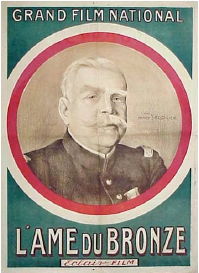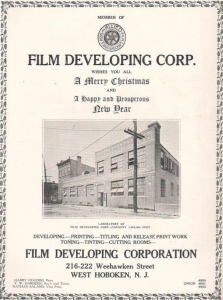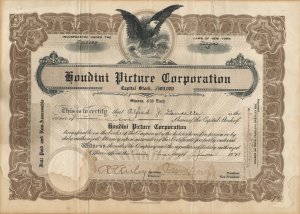93 Years Ago Today, December 27, 1921, Houdini became the figurehead of The Mystery Pictures Corporation. Note: This is not the Houdini Picture Corporation (HPC), nor the Film Developing Corporation (FDC) which wishes you all A Merry Christmas and A Happy and Prosperous New Year
FDC: Houdini invested in the FDC in 1916. It was founded upon a novel invention: a method of automated film processing, developed by Gustav Dietz. Offices were opened on Broadway, and a factory in Hoboken, New Jersey. Houdini’s initial investment was $4,900 but the company was never able to turn a profit. In April, 1918, Houdini fired Dietz and attempted to improve upon the mechanism himself, assigning his brother, Theodore W. Hardeen, to run the company, all to no avail.
HPC: It seemed only natural that, owning a film processing company, he should make his own films, rather than relying on the resources and expertise of a motion picture studio. He formed the Houdini Picture Corporation (HPC) in early in 1921. By October of 1921, seven months after incorporating HPC, Houdini had wrapped up two full-length feature films, The Man From Beyond and Haldane.
Even though The Moving Picture World had announced that the HPC would produce “four feature productions a year, in which Houdini will be the star,” the filmmakers must have quickly realized how impossible it would be to live up to this ambition. So Houdini sought other ways to keep the FDC busy, and to shore up his film-making empire.
The Mystery Pictures Corporation was formed.
During his tours through Europe, he had discovered that there were many high-quality films there that might never be exported to the U.S. What they lacked in popular American stars, they made up for in production values. Harry Houdini was the President. Hardeen was vice president and Harry H. Poppe served as Secretary.
 Films imported for distribution included: 1918 French Film L’Ame du bronze (Soul of Bronze), Les Contes de mille et une nuits (A Thousand and One Nights), and 1919 Italian Film II mistero di Osiris (The Mystery of the Jewel). Note: The Mystery of the Jewel was renamed and released as Ashes of Passion.
Films imported for distribution included: 1918 French Film L’Ame du bronze (Soul of Bronze), Les Contes de mille et une nuits (A Thousand and One Nights), and 1919 Italian Film II mistero di Osiris (The Mystery of the Jewel). Note: The Mystery of the Jewel was renamed and released as Ashes of Passion.
Realizing that producing his own features (as the Houdini Picture Corporation) and acquiring foreign films for distribution (as the Mystery Pictures Corporation) were losing propositions, Houdini finally brought his commercial film career to a close.
Source:
- Houdini The Movie Star Film Notes by Bret Wood
- The Secret Life of Houdini by William Kalush and Larry Sloman




Wow Joe! Didn’t know (or forgot) about the MPC. Let’s see:
1. The FDC
2. The HPC
3. The MPC
How much money did Houdini lose in the end? Afterwards I’m going here to estimate the losses in today’s money:
http://www.measuringworth.com/
LOL!
WRT the FDC, Houdini wrote Kellar on October, 1920 that he had over 100,000 dollars invested but had never received a penny from same.
As far as the HPC, I am not really sure how TMFB did. But I believe Houdini just about broke even with Haldane.
The MPC appeared to have followed the same path of the ill-fated FDC.
The campaign costs and the production of pictures finally drained him of his enthusiasm for movie making.
I don’t believe anybody can pull out documents that detail Houdini’s losses in the film industry. I couldn’t find box office totals for TMFB on the IMBD website. Even with that we still don’t know what it cost him. Those ledger sheets were most likely filed away in his accountant’s office somewhere in New York City. They were in all probability shredded and disposed of when his accountant retired.
But supposing he lost something like $50,000, it would amount to half a million in today’s money.
According to Kalush, the only positives from Houdini’s involvement in motion pictures were that it spread his fame worldwide and greatly increased his vaudeville salary, ironically at a time when he had no real interest in performing again.
You win some, you lose some.
If HOTSS broke even at the box office, then Houdini really made it on a tight budget because it didn’t fare well at the box office. I forgot about the advertising factor of the movies and how it publicized Houdini even more. Instead of thinking of film as a financial failure for Houdini, one can say that the movies amounted to an advertising expense for him that eventually paid dividends in box offices where he performed in Britain and the U.S.
Well said Leo. Houdini cut every conceivable corner in HOTSS. It was released by the low-budget Film Booking Offices (FBO) which would later evolve into RKO. FBO had informed Houdini that they could get him more play-dates for his picture.
The advertising definitely paid dividends. When the critics panned the film, Houdini decided to launch a major advertising campaign. Large life size cutouts of himself bound in chains were dispatched to theaters playing the picture. Thousands of small slips of paper bearing the message: “This lock is not HOUDINI-proof. He could pick it as easily as you pick a daisy. See the Master-Man of Mystery in Haldane of the Secret Service, A picture that will thrill you to your marrows” were inserted in the keyholes of doors, in cities the picture was playing.
I had no clue houdini had his own movie company, very interesting.
Glad you found it interesting. There are many facets to Houdini.
I understand that John at WAH is working on a book about the film phase of Houdini’s life. Should be interesting and might answer some of the financial mysteries.
I would welcome a book about the film phase of Houdini’s life. I know at one time John wanted to do a book, but then he decided to concentrate on his web-site. I wonder if this will be an eBook created from his web-site or if he has something else in mind. I guess we will have to get the details from John.